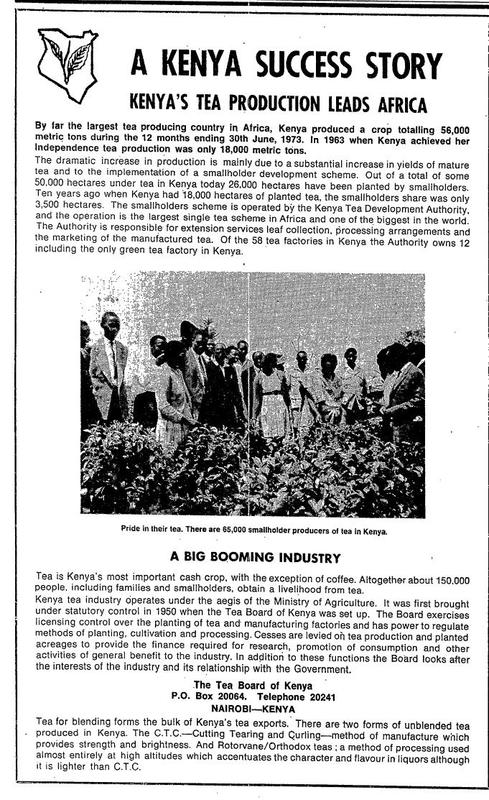The Impact of Small-scale Tea Farmers: A Success Story?
This advertisement was carried out by the Tea Board of Kenya in September 1973. The advert appeared in the Times London, highlighting the importance of small scale farmers in Kenya's tea sector. There are more than 600,000 smallholders producing tea in Kenya, usually with plots between 4 and 8 hectares.
The advert details the "successes" of small scale farmers, especially on how they had helped increase Kenya's tea acreage from 3500 acres in 1963 to more than 18,000 acres in tea farms in 1973. Interestingly, the advert also paints a very positive picture about the Board’s achievements, especially on how it had helped farmers learn new tea planting and processing methods, and access credit. On the other hand, the advert fails to address issues touching on market access by small scale farmers or even acknowledge that small scale farmers have difficulties transporting their tea harvests to the markets due to poor roads. Generally, most small-scale farmers in Kenya’s tea sector are "price takers;” they sell their tea to collectors, plantations or processors (Chan et al., 2009). Although they account for the majority of tea produced in Kenya, their average yield per year is lower than that of tea estates/plantations (Kenya Tea Board, 2015). This is not surprising because majority of small-scale farmers lack inputs, still lag on technology innovations that helps detect weather changes, and do not possess economies of scale (Porter, 1985). The main challenges in the small-scale tea sub sector include also include low farm gate prices, poor extension services, and limited marketing channels (Chan et al., 2009).
Moreover, the cost of production for small-scale farms is lower than those of plantations because of concealed family costs; family labor is utilized, especially during the harvest season and this data is not accounted for when calculated the net profit for the small-scale farmers. Sorensen (1990) argues that the use of women’s labor has become an area of negotiation and tension between the sexes, particularly between wives and husbands. Her findings are supported by empirical findings for other regions of Kenya, and other African countries. Most smallholder farmers take utilize family labor. In this regard, gender relations in the household affects how work is distributed. Among the Kalenjin community, tea was introduced to them as a male crop (Sorensen, 1990). Furthermore, land rights and ownership were also transformed, and as Sorensen points out, tea licenses were issued to male household heads on the basics of title deeds to land.

